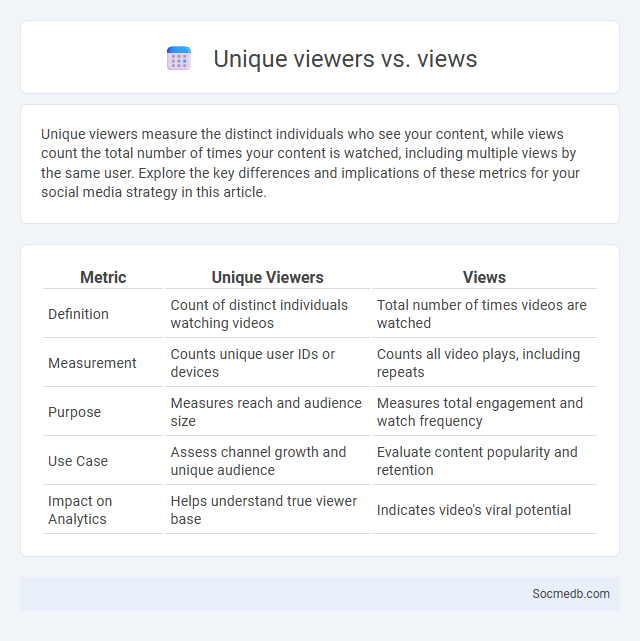
Photo illustration: Unique Viewers vs Views
Unique viewers measure the distinct individuals who see your content, while views count the total number of times your content is watched, including multiple views by the same user. Explore the key differences and implications of these metrics for your social media strategy in this article.
Table of Comparison
| Metric | Unique Viewers | Views |
|---|---|---|
| Definition | Count of distinct individuals watching videos | Total number of times videos are watched |
| Measurement | Counts unique user IDs or devices | Counts all video plays, including repeats |
| Purpose | Measures reach and audience size | Measures total engagement and watch frequency |
| Use Case | Assess channel growth and unique audience | Evaluate content popularity and retention |
| Impact on Analytics | Helps understand true viewer base | Indicates video's viral potential |
Understanding Unique Viewers: Definition and Importance
Unique viewers refer to individual users who visit a social media profile or content within a specific time frame, counted only once to avoid duplication. Measuring unique viewers is crucial for evaluating reach, audience engagement, and the effectiveness of marketing campaigns, providing insights into genuine audience size rather than total views. Businesses and influencers leverage unique viewer metrics to tailor content strategies, optimize advertising budgets, and enhance user targeting for improved social media performance.
What Are Views? Breaking Down the Basic Metric
Views on social media represent the number of times a piece of content, such as a video or post, has been watched or seen by users, serving as a fundamental metric to gauge initial engagement. Each platform defines a view differently; for example, YouTube counts a view after a user watches at least 30 seconds of a video, while Instagram counts a view instantly when a video autoplays. Understanding the specifics of how views are measured helps marketers and creators accurately assess content performance and optimize strategies to increase visibility and reach.
Unique Viewers vs. Views: Key Differences Explained
Unique viewers represent the individual users who have seen your content at least once, while views count the total number of times the content is watched regardless of repeated views by the same user. Measuring unique viewers helps gauge the breadth of your audience reach, essential for assessing campaign effectiveness and audience growth. In contrast, view counts provide insight into engagement levels and content popularity, reflecting how often users interact with your posts.
The Role of Analytics Dashboards in Performance Tracking
Analytics dashboards play a crucial role in social media by providing real-time insights into key performance indicators such as engagement rates, follower growth, and campaign effectiveness. These dashboards aggregate data from platforms like Facebook, Instagram, and Twitter, enabling marketers to identify trends and optimize content strategies. Enhanced visualization tools facilitate faster decision-making, boosting ROI and ensuring targeted audience reach.
How Analytics Dashboards Aggregate Viewership Data
Analytics dashboards collect viewership data by integrating APIs from multiple social media platforms, capturing metrics such as likes, shares, comments, and follower growth in real-time. Advanced algorithms process this information to identify trends, viewer demographics, and engagement patterns across platforms like Facebook, Instagram, Twitter, and TikTok. These aggregated insights enable marketers to optimize content strategy and measure campaign performance with precision.
Interpreting Unique Viewers on Your Analytics Dashboard
Interpreting unique viewers on your social media analytics dashboard helps identify the actual number of individual users engaging with your content, providing a clearer picture of your reach and audience behavior. Monitoring unique viewers over time reveals trends in content popularity and audience growth, essential for optimizing your marketing strategies. You can use these insights to tailor your posts and improve engagement by focusing on what resonates most with distinct segments of your audience.
Views Through the Lens of Analytics Tools
Social media views are accurately measured using advanced analytics tools that track user engagement, video completion rates, and viewer demographics. Platforms like Facebook Insights, YouTube Analytics, and Instagram Insights provide detailed metrics, enabling marketers to optimize content strategy based on audience behavior patterns and peak activity times. Data-driven adjustments to posting schedules and content formats significantly enhance view counts and overall campaign effectiveness.
Actionable Insights: Leveraging Unique Viewers and Views
Analyzing unique viewers and total views on your social media platforms provides actionable insights that help tailor content strategies for maximum engagement. Tracking unique viewer metrics reveals the size of your audience reach, while view counts indicate content popularity and user retention trends. Using these data points enables you to optimize posting times, refine messaging, and boost overall social media performance.
Common Pitfalls in Analyzing Viewership Metrics
Misinterpreting social media viewership metrics often leads to overestimating engagement by relying solely on vanity metrics such as likes and shares, which do not accurately reflect audience behavior or content effectiveness. You must account for metrics like watch time, audience retention, and demographic data to gain deeper insights into your content's impact. Neglecting to segment viewership data by platform and content type can result in misguided strategies that fail to address specific audience preferences and trends.
Best Practices for Using Analytics Dashboards Effectively
Maximize the benefits of social media analytics dashboards by regularly monitoring key performance indicators such as engagement rates, follower growth, and conversion metrics. Customize dashboard widgets to align with specific campaign goals, ensuring data relevance and facilitating quick decision-making. Schedule consistent data reviews to identify trends, adjust strategies, and improve overall social media ROI.
 socmedb.com
socmedb.com